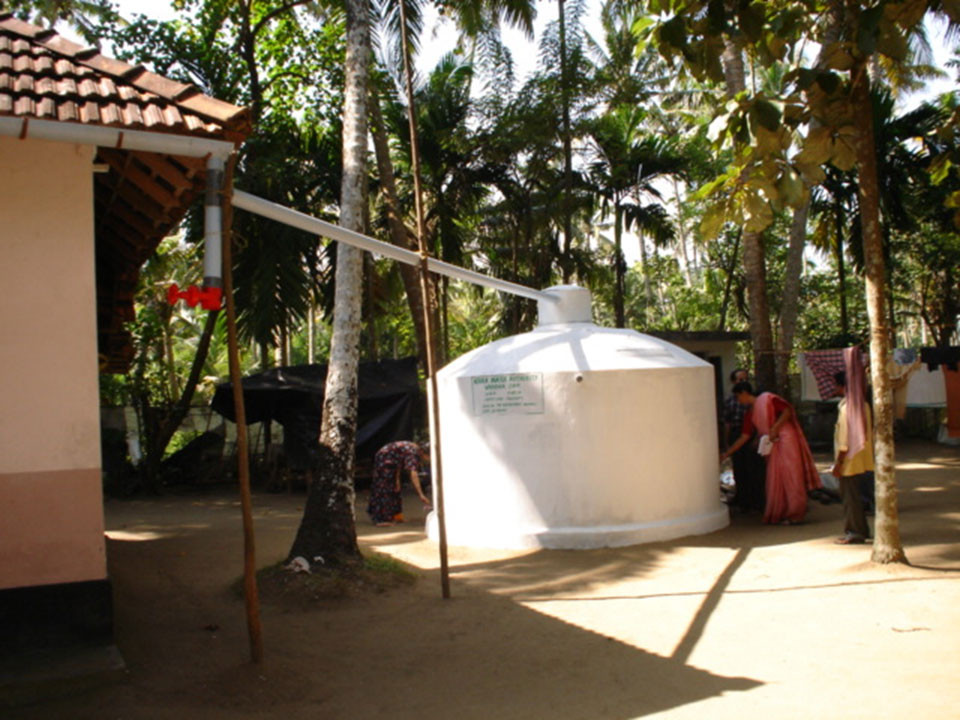
Kerala, often referred to as “God’s Own Country,” is renowned for its lush landscapes and heavy monsoon rains. While the state enjoys an abundance of rainfall averaging over 3,000 mm annually this natural resource is not always harnessed effectively. The monsoon rains that flood the region can lead to waterlogging and flooding, while at the same time, the state faces periodic water shortages, particularly in the dry months. To tackle this issue, rainwater harvesting (RWH) can be a sustainable solution. There are various techniques of rainwater storage that can be effectively utilized in high-rainfall states like Kerala to capture, store, and manage this precious resource.
1. Rooftop Rainwater Harvesting
One of the simplest and most widely used methods of rainwater harvesting in Kerala is rooftop rainwater collection. This technique involves capturing rainwater from rooftops, filtering it, and storing it in tanks or underground reservoirs. Kerala’s traditional tiled roofs, commonly found in homes, can be perfect for this system, as they provide a smooth surface for rainwater collection.
The process begins with rainwater flowing through gutters that channel the water into pipes. Before being stored, the water is filtered to remove debris and impurities, ensuring it is safe for domestic use. The water can then be stored in above-ground or underground tanks. Underground storage is ideal for maintaining a cool temperature, preventing algae growth, and ensuring that the water remains clean. The harvested water can be used for drinking, irrigation, and other domestic needs, reducing reliance on external water sources.
2. Percolation Pits and Recharge Wells
In Kerala’s high-rainfall areas, another effective method is the construction of percolation pits and recharge wells. These systems are designed to allow rainwater to seep into the ground and recharge the groundwater table. Percolation pits are small depressions or shallow pits filled with sand and gravel that capture rainwater, allowing it to percolate deep into the soil. This helps replenish local groundwater levels, which is especially useful in areas that rely on borewells and wells for water supply.
Recharge wells are deeper, vertical wells designed to collect rainwater and direct it into the groundwater system. These systems help increase the local water table and reduce the risk of water shortages in dry periods. Both of these methods are highly suitable for Kerala, where the abundance of rainfall can be converted into a resource for sustaining groundwater.
3. Check Dams and Small Reservoirs
In areas where water runoff is high, especially in the hilly regions of Kerala, check dams and small reservoirs can be constructed to store rainwater. Check dams are small barriers built across streams or rivers to slow down the flow of water. These structures allow rainwater to accumulate behind them, preventing water from being lost to runoff and enabling it to seep into the ground.
Similarly, small reservoirs built along rivers or streams can collect water during the monsoon season. These stored reserves can be used during the dry season to meet the water demands of nearby communities. Check dams and reservoirs also help in mitigating floods by reducing the speed of flowing water during heavy rains.
4. Pond and Lake Harvesting
Another traditional method of rainwater storage used in Kerala is pond and lake harvesting. Communities have historically relied on large ponds and lakes for water storage. These water bodies collect and store rainwater during the monsoon season, providing a steady supply of water throughout the year. While not as widely practiced today, reviving and maintaining these water bodies can be an effective strategy for rural areas of Kerala to manage rainfall efficiently.
5. Rainwater Harvesting for Agriculture
In Kerala, agriculture is a major part of the economy, and utilizing rainwater for farming can make a significant difference in water management. Rainwater can be harvested and stored in ponds or tanks, which can then be used for irrigation purposes, especially in areas that face water scarcity during the non-monsoon months. Drip irrigation and sprinkler systems can be coupled with stored rainwater to ensure that crops receive consistent water, improving yields while conserving water resources.
Conclusion
With the changing climate and unpredictable rainfall patterns, Kerala, despite its high rainfall, faces water management challenges. Implementing diverse rainwater storage techniques such as rooftop harvesting, percolation pits, check dams, and pond harvesting can help mitigate the impact of water shortages and floods. By integrating modern rainwater harvesting systems with traditional methods, Kerala can ensure sustainable water management, reduce dependency on external water sources, and preserve its water resources for future generations. This holistic approach to rainwater storage not only addresses water scarcity but also promotes environmental conservation, making it an essential step toward sustainable living in high-rainfall states like Kerala.


